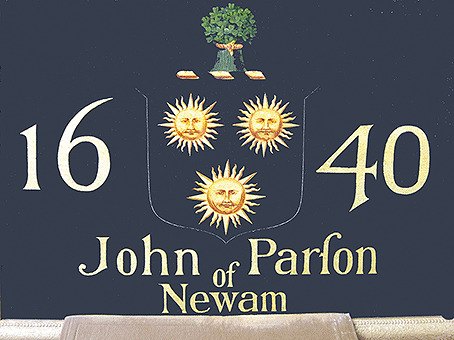Steyning Museum Archives: The Parson Family of Newham
Wednesday 1st May In 1639 the plague came to Steyning. The sexton would usually have expected to dig some 15 graves each year but, between the winter of 1639-40 and that of the following year he had to contend with 78 deaths and there were yet more in the year after that. Particularly hard hit was the Parson family. John Parson lost his only son and 'heyre apparent' (also called John), and four grandchildren, plus Dulce, an older member of the same family.
In 1639 the plague came to Steyning. The sexton would usually have expected to dig some 15 graves each year but, between the winter of 1639-40 and that of the following year he had to contend with 78 deaths and there were yet more in the year after that. Particularly hard hit was the Parson family. John Parson lost his only son and 'heyre apparent' (also called John), and four grandchildren, plus Dulce, an older member of the same family.The Parsons were a prosperous local family who, for several generations, had been described as ‘yeomen’ – yeomen being what we would now think of as farmers. Their landholdings, however, were scattered across the local landscape in a way which would be unfamiliar to the modern farmer.
For instance, when Thomas Parson died in 1565, he was farming more than fifty different fields and plots of land. Seven of them were crofts – separately enclosed small fields of between one rood (about the size of two tennis courts) and three acres. One of the croft’s adjoined a house called Mawdlyn and another an oratory [possibly the church at St. Botolphs). A further three of the landholdings were messuages – dwelling houses with land attached – one of which was 'a messuage with a garden at Singwell in the tithing of Southbroke in Stenyng'. Most of his land he didn’t actually own. This messuage was 'held of the Queen as of her manor of Woking by fealty in free socage and not in chief; and is worth 10s' – ‘free socage’ being a form of land tenure and ‘fealty’ an oath of allegiance.
This is all complicated enough, but he also had various strips of land in the open fields of Bidlington (the portion of Bramber Parish next to Steyning), in Wickham and in Steyning plus access to 'a certain common called the Downes'. The number of strips is not mentioned but, in Wickham, they added up to 20 acres (possibly incorporating ten to fifteen strips) of which two were meadowland in the 'common meade'.
The only coherent bit of landholding was in Bidlington where he farmed 80 to 90 acres split between seven fields though, even there, they managed to introduce another type of confusion. Thomas 'was seised', so the record shows, 'of a field called Twelve Acres containing 16 acres and a field called Tenne Acres containing 15 acres.'
By 1640, when the family were suffering such tragic loss, they were living at ‘Newam’ (Newham) and their land holdings had temporarily increased. Following the death of a son-in-law they had acquired the wardship of a substantial farm at Aldingbourne during their grandchild’s minority. Then, over the next twenty years, they climbed yet further up in the world. By 1661 John Parson was describing himself as being of Steyning and the Middle Temple and had acquired a coat of arms – 'Per fess sable & azure, three suns or' – and a crest – 'A garb of trefoils vert, band or'. The interpretation of this (shown here) is not contemporary; it was created over one hundred years ago by a later occupant of Newham House. 1640 was, in fact, the earliest mention of the name ‘Newham’ in our records.
Attempts have been made to explain the name by linking it to a local ‘manor called Ewelme’, suggesting a derivation from ‘atten elm’ and thence to Newham. But we don’t know whether this manor lay anywhere near Newham. Between 1378 and 1630 it is only ever mentioned in conjunction with Wickham and Annington. Moreover, its name is just as likely to be derived from a spring – as is that of the Oxfordshire manor of the same name. Perhaps, instead, the name Newham (a new home or settlement) was chosen for this substantial house when it was first built in the 16th century and that the Lane going past its front door became known by the same name.
The thread of history running from a plague to the naming of Newham Lane is, as ever, as complicated as Thomas Parson’s landholding.
Article by: Chris Tod - Steyning Museum.